
Dyan Anggraini
From top to bottom
"Bunda" - Metal, cloth (155 × 35 x 2 cm each) 1 - 15) (2018_
*Kedudukan 'Perempuan-Bunda' mengandung titah suci yang seringkali
berhadapan dengan rintangan dan bahaya dalam hidupnya"Koor Bungkam" - Ink on Paper (30 × 22 cm each) 1 – 24, (2012)
Otokritik atas sebuah teks yang sedang membicarakan budaya birokratisme yang penuh praktik seremonial
"Perjalanan"- Resin, metal, ink. (30 x 50 x 30 cm each), 1 – 20, (2021)
Langkah panjang melelahkan, penuh rintangan, menyakitkan, namun tetap melangkah ke depan dalam sabar,
ihlas.....menjadi kekuatan yang nenghantar sampai tujuan. " Priyayi"- Acrylic on Canvas, 80 x 60 cm, (2004)
"Tiwikromo"
Dyan Anggraini (b. 1957)
Dyan Anggraini is a very special figure in the world of contemporary art in Indonesia. A persona who has benefitted the Indonesian art world by closing the gap between artists and the rigid system of bureaucracy. She entered the Taman Budaya Yogyakarta in 1989 in the spirit of idealistic engagement, eager to serve the development and strengthening of art. Starting off as just an employee who was ready to do any job as needed, she became a visionary leader in many ways. In 2004 she was appointed as the head of the institution. Under her leadership until 2011, Taman Budaya Yogyakarta which was tasked with the development of art and culture in the region, grew into a progressive government institution that was well equipped to face the rapidly changing dynamics in the art world. This was supported by her open policy involving artists and the general public in the planning of activities and developing designs for TBY.
In a further vision for the development of art and culture, Dyan in her position as Head facilitated the founding of the Yogyakarta Biennale Foundation, supported the later popular ArtJog , and instilled in artists the sense of a home at Taman Budaya, cofounded ‘Anak Kolong Tangga museum of children's toys, initiated the Mata Jendela quarterly and 'Art for Children' program for kids, and established the annual event of 'Pasar Kangen Jogja' meant to foster cherished memories of the atmosphere of Yogyakarta’s traditional markets. After Taman Budaya, she became Director of Traditions, Arts and Film of the Yogyakarta Provincial Office of Cultural Affairs.
It is impossible to mention all the many ways Dyan Anggraini has contributed to a favorable state of art and culture in the province and beyond. For her services, the government of the Special Region of Yogyakarta presented her the Culture Award in 2019 for fostering and sustaining art.
Dyan Anggraini was born in Kediri in 1957 to parents who were both educators in the progressive nationalistic school of Tamansiswa. Going to elementary and middle school at Tamansiswa. Dyan grew up in a spirit of nationalistic modernity which included art and culture and modern principles of humanity and gender justice, while honing the Javanese philosophy of equilibrium and balance.
In 1978 Dyan Anggraini enrolled at the STSRI "ASRI" (Indonesian Academy of Fine Arts) Yogyakarta, and became part of the art dynamics of the time, experimenting with pop art and the likes of Warhol, but somehow she retained a style of her own and always stood by her principles. Already as a young student she had the courage to defy the mainstream painting-only paradigm by morphing a 3 dimensional collage into her painting. More than just a collage, she added baby dolls and soldier dolls in red plastic making it appear like a 3-D of protest. But she insisted it was just a symbol of humanity. She graduated in 1982. Then she married and moved to Madura and stayed there for seven years following her spouse, a dentist working in Sampang Regency, Madura Island. After seven long years in Madura and with only sporadic access to art and cultural information, she returned to Yogyakarta in 1989 where she held her first solo exhibition of works created while in Madura.
Eager to reconnect, she jumped at a vacancy at the Taman Budaya office. She wanted to serve to strengthen the institution, and worked to narrow the gap between artists and the rigid structure of bureaucracy. When the position to head the institution became available, she was offered it, but declined in the first instance as she was reluctant to fill that high-level position. Nevertheless, she seemed to be the only person to qualify and she was urged to accept, which she ultimately did in 2004.
Her experience within the bureaucracy has had a significant impact on her art. The struggle between the values she held dear and the realities of the bureaucracy deeply inspired her artistic urges and saw her initially move to anecdotal caricatures in which masks became a potent vehicle to express critical comments which she could not express verbally. The importance of masks in her art evolved over the course of her solo exhibitions from 2004 onwards culminating in 2007 with her solo exhibition DeocraGent.
A humorous tinge evaded eventual repercussions and she went on to make images of what she called ‘clowns.’ The figure of a bare-chested bureaucrat with only a tie to cover his body is self-explanatory, as is an empty chair with masks on it under the title Waiting for the Clowns. A surreal image as if foreseeing no end to the clowns was rendered in Seribu Topeng di Wajah (A Thousand Masks on the Face) featuring a male with a cloth tied over his eyes and going out as a long tail laid with masks blows in the wind.
If she used masks for critical comments on others, those that marked her series of self with wide-open eyes as if in terror and closed or half open mouths, was a repressed outcry of the almost unbearable torment that she had to endure. Clenching and squeezing fists as well as safety pins emerged in her installations as expressions of frustration or hidden elicitors of pain.
Along with her work as a bureaucrat, Dyan persistently continued working as an artist (6 of her 10 solo exhibitions were held while in office). As she succeeded in fostering Taman Budaya Yogyakarta and its art scene, this is matched by a maturing of her art that makes the intangible tangible, while reaching the level of the sublime. Meanwhile a qualitative research paper (authors Suardana R Angga Bagus, R Angga Bagus Kusnanto, I Wayan Suardana) titled Femininety in Painting of Dyan Anggraini and its Implementation of Gender Mainstreaming was discussed in the International Congress on Art and Arts Education(ICAAE), 2018, highlighting the motherly in her praxis as a bureaucrat and her artistic pursuit.






